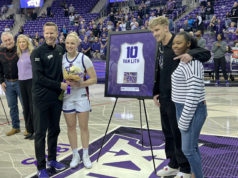It’s a pretty good time for women’s sports right now. We shouldn’t take it for granted – not yet.
This past week, I spent some time around the Dallas Trinity FC women’s soccer club. The context had to do with a docuseries I directed called “Raising Her Game” (now streaming on Victory+) that traces the concurrent evolution of U.S. soccer and women’s sports through the lens of the University of Texas women’s soccer program. I knew from the research for that project some of the challenges women faced just to get an opportunity to play their sport(s) of choice, in this case soccer (aka football in much of the world). From Deborah Abiodun, I learned some of those obstacles still exist.
“I’m from Nigeria and back home where I’m from, it is very difficult for girls like myself to be encouraged to play football,” the midfielder explained. “It’s very difficult for parents to encourage their female child to play soccer, and it is a very big challenge that still needs to develop.”
Abiodun managed to overcome an environment that sought to limit her gender’s participation in the country’s most popular sport.
“I had to go through a lot of struggle to be where I am today,” she said. “I had to go against my family’s wish, because at first they didn’t encourage me playing soccer. But now they’re in full support.”
She has since played for her national team in the Women’s World Cup and the Olympics. The man who coaches that squad, Randy Waldrum, also serves as head coach for the University of Pittsburgh women’s soccer team. I learned about Abiodun when we interviewed Waldrum for the docuseries. He explained that she came to him for assistance.
“She was almost in tears. And she said, ‘Coach, will you please take me to the US to come to your school?’ And I said, ‘You want to come to the US? Why?’ She said, ‘Coach, I need an education. I need to be able to provide for my family.’”
Abiodun twice earned All-ACC honors playing for Waldrum at Pitt. He noted that most promising players from her country often take the first pro opportunity that comes their way, even if it might not be the best situation for the long run. I showed Waldrum’s clip to Deborah before our interview.
“Watching that made me feel so excited, and I’m so grateful. And you know, I got to take that opportunity to go to college, because, like he said, most of the young girls from where I’m from don’t really have the opportunity to, like, go to college while playing soccer, it’s mostly you choose one or the other. You know, like you either go to school or forfeit your dream of playing soccer, or you go play soccer and don’t have the opportunity to get a degree.”
During the course of the documentary production, I learned about how the U.S. university sports system had a huge effect on not only developing American women soccer players, but also played a role in helping players from other nations. At a Dallas Trinity FC luncheon Friday, I chatted with Maja Henriksson, who came from Sweden to play at Keiser University and Nova Southeastern University before going pro. Her native country had been among the early pioneers in providing women with soccer opportunities. But a number of prominent footballing nations not only cast aspersions on the women’s game, their football associations outright forbade playing sanctioned matches during much of the 20th century.
“Back home, the game was banned for a long time,” explained Dallas Trinity FC assistant coach Gavin Beith. “Females didn’t have the opportunity to play soccer.”
In 1971, UEFA, the European soccer governing body, held a vote to bring the women’s game under the jurisdiction of each member’s national association. Scotland’s delegation cast the only “no” vote.
I learned through the documentary process how Texas coach Ange Kelly’s family moved to Canada from Scotland in the 1970s and she found athletic opportunities her mother’s generation never had. When the Scotland native Beith turned pro as a player with Dundee F.C. in the early 2000s, no comparable pathway existed for women in the country. Beith saw that start to change as he stayed in the game after his playing days.
“When I stopped playing professionally, or was more part-time professional, I started working with the Scottish Football Association. So part of the association back home is to grow every strand of the game,” Beith said. “Every region back home has a designated girls and women’s development officer who would be responsible for growing female sporting areas.”
The country now has a pathway for women to play, with the Scottish Women’s Premier League sitting at the top of its development pyramid. Beith coached at that level before coming to Dallas.
Women’s leagues in many countries have also accelerated in recent years. Since leaving the University of Texas, Haley Berg has played professionally in Denmark, Turkey, Iceland, Spain, and now Dallas. When she entered college in 2017, less than a decade ago, most of those locales would not have been viable choices for women hoping to make a living kicking a soccer ball.
“There are so many more opportunities. I didn’t even know going overseas could also be an opportunity for me,” she said. “There are so many other amazing leagues that you can go to and I think it was such a learning process.”
Berg is one of a dozen players from the North Texas area on the DTFC roster. At Friday’s luncheon a couple of those athletes, Chioma Ubogagu and Allie Thornton, expressed in a panel discussion how pleased they were to have a team in their home region. Indeed, all the American players seem grateful to have a second domestic league (the USL Super League, in which Dallas Trinity competes, is in its inaugural season) to complement the 12-year-old National Women’s Soccer League.
“With this league, we don’t all have to just go overseas and be away from everyone for so long,” said Garland native and University of Texas product Cyera Hintzen. “There’s more opportunity for us here in America, and I just see it growing so much and so big, so fast, and I’m really excited to see where it’s going.”

“Now we have a women’s professional soccer team in Dallas. And it’s so cool to see these girls come out to the Cotton Bowl, which is probably 30 minutes away from everyone, just to see something that they can strive to be,” said Camryn Lancaster of Mansfield and TCU. “It’s really cool to see all these offers that are available for women and everything that is going on around soccer.”
It was fun watching a group of girls in matching soccer jerseys chanting along with the supporters group as they watched Lancaster and her teammates at Wednesday night’s DTFC win over DC Power FC. Those youth players may have a chance to grow up taking for granted that they can play soccer themselves and have a team to watch or even aspire to play for.
It hasn’t always been that way. Dallas Trinity forward Lucy Shepherd talked on the luncheon panel about playing on a boys team in her youth in England in order to find a level of competition that matched her advanced skills. She’s 25 years old, which gives one an idea of how recently women’s soccer became a priority in the game’s birthplace.
I explored in the docuseries how athletic opportunities enabled by Title IX legislation pushed women’s soccer development in the U.S. at a faster pace than other locales. That movement influenced other countries to a certain extent and, indeed, continues to do as Deborah Abiodun’s path to college and the pros exemplifies. But her experiences also show the attitudes that enabled the present-day advancement of women’s opportunities are not yet universal. It took a lot of work to get to this point and there is still more to do to ensure that little girls in Lagos or Dallas or Glasgow can take their prerogative to engage in sporting pursuits as a given.












